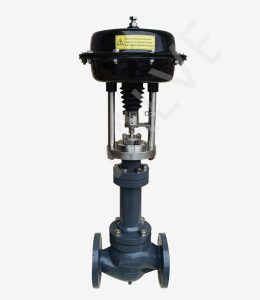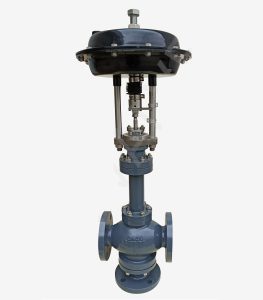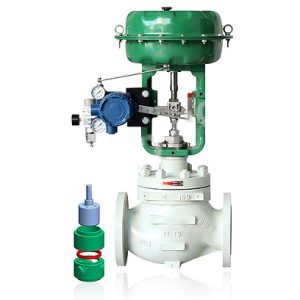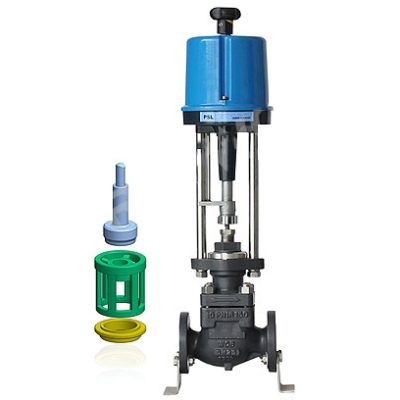Effective steam flow management is critical for maintaining efficiency, safety, and cost control in industrial operations. Selecting the right control valve can significantly enhance system reliability and performance. Among the options available, the Steam Control Valve stands out as a versatile solution for managing steam flow precisely. Similarly, the steam flow control valve, with its ability to maintain consistent flow, ensures stable operation under varying conditions. For processes requiring pressure adjustments, the steam pressure reducing valve and steam pressure regulating valve provide superior accuracy and adaptability. Understanding the specific requirements of your system, including pressure, temperature, and flow demands, is essential to choosing the best valve for seamless steam flow management and achieving long-term operational excellence.
Introduction control valve
Control valves play a pivotal role in effective steam flow management across industrial applications, ensuring optimal efficiency and safety. Designed to regulate steam under various conditions, these valves are critical for maintaining system stability. Options like the Pneumatic diaphragm control valve and Pneumatic globe valve are favored for their precision and reliability in demanding environments. Additionally, valves such as the temperature regulating valve ensure accurate thermal control, which is essential for processes sensitive to heat variations. With expertise from leading pressure regulating valve manufacturers, industries can achieve seamless integration of control solutions tailored to their specific operational needs. Selecting the right control valve not only safeguards equipment performance but also reduces energy consumption and enhances overall system longevity.
Types of Control Valves for Steam Flow
When managing steam flow, selecting the appropriate control valve is crucial to ensure efficiency and precision. Among the options, globe valves are renowned for their excellent throttling capabilities, making them ideal for fine steam flow adjustment. Butterfly valves, on the other hand, offer a lightweight and cost-effective solution for high-capacity systems. For quick operation and versatility, ball valves are often the preferred choice due to their compact design and reliable sealing. Additionally, diaphragm valves excel in applications requiring minimal leakage and high accuracy. Each valve type brings unique advantages, enabling industries to match the control valve to specific process demands and operating conditions.

Overview of key types of control valves used in steam handling systems:
Globe Control Valve – Known for its precision and reliability in steam flow regulation.
The globe control valve stands out as a top choice for steam flow regulation due to its exceptional precision and reliability. Its unique design, featuring a spherical body and a linear motion mechanism, allows for accurate throttling and flow control. These valves can handle varying steam pressures and temperatures, making them ideal for demanding applications in power generation, chemical processing, and manufacturing industries. Their robust construction ensures durability, while their ease of maintenance further enhances operational efficiency. With the ability to manage even subtle flow adjustments effectively, globe control valves are a preferred solution for industries requiring precise and dependable steam management.
Butterfly Control Valve – Lightweight and cost-effective, ideal for larger steam flow systems.
The butterfly control valve is an excellent choice for managing larger steam flow systems due to its lightweight design and cost-effectiveness. Its simple construction consists of a rotating disc that swiftly and efficiently regulates steam flow, making it ideal for processes requiring quick adjustments. Butterfly valves are particularly suited for high-capacity systems in industries such as power plants, food processing, and petrochemicals, where handling large volumes of steam is critical. Their compact size minimizes installation space, while their competitive pricing ensures affordability without compromising performance. With a balance of efficiency and durability, butterfly control valves meet the demands of large-scale steam flow systems effectively.
Ball Control Valve – Offers quick response times and compact design.
The ball control valve is a versatile solution for steam flow regulation, valued for its quick response times and compact design. Featuring a rotating ball with a hollow center, this valve enables precise on-off control and rapid adjustments, which are critical in dynamic steam systems. Its compact structure allows for easy installation in tight spaces while maintaining high performance. Ball valves are widely used in industries like manufacturing, pharmaceuticals, and energy sectors, where efficiency and reliability are paramount. Their robust sealing capabilities and adaptability across various steam pressure ranges make them a preferred choice for effective and efficient steam management.
Diaphragm Control Valve – Frequently used for applications requiring high accuracy and minimal leakage.
The diaphragm control valve excels in applications where high accuracy and minimal leakage are essential for steam flow regulation. Its innovative design, utilizing a flexible diaphragm and a precise sealing mechanism, ensures superior flow control and nearly zero leakage, even under varying pressures. This makes it an excellent choice for industries such as pharmaceuticals, chemical processing, and food production, where precise steam management is critical to maintaining product quality and operational efficiency. Renowned for its reliability and consistent performance, the diaphragm control valve is a trusted solution for processes demanding tight control and adherence to stringent safety and regulatory requirements.
Highlight how each type of control valve works and its suitability for different steam flow scenarios.
Each control valve type offers distinct functionalities tailored to specific steam flow scenarios. Globe valves, with their spherical design and linear motion, excel in precise throttling and consistency, ideal for industries prioritizing accuracy. Butterfly valves, featuring a rotating disc, are lightweight and cost-effective, making them suitable for large-volume steam systems where space and budget are concerns. Ball valves, utilizing a hollow, pivoting ball, provide rapid on-off control, efficient for dynamic systems demanding quick response times. Diaphragm valves, with their flexible sealing mechanism, ensure high accuracy and minimal leakage, meeting the stringent requirements of applications such as pharmaceuticals and food production.
Factors to Consider When Choosing a Control Valve
Selecting the right control valve for steam flow management requires careful consideration of several factors. The type of steam system—whether it demands precision, high volume, or quick response—is crucial in narrowing down options. Pressure and temperature ratings must align with system requirements to ensure safety and performance. The valve material is another important aspect, as it should resist corrosion and tolerate extreme conditions. Maintenance needs also play a role, with certain designs offering easier access for servicing. By evaluating these elements, industries can identify the most effective valve solution, balancing performance, durability, and cost-efficiency for their specific steam flow application.

Key factors to evaluate during valve selection:
Steam Pressure and Temperature – Compatibility with system conditions.
Steam pressure and temperature compatibility is a critical factor when selecting a control valve for efficient steam flow management. A valve must be rated to handle the specific pressure and temperature ranges of the system to maintain performance and safety. Using an incompatible valve can lead to failures such as leaks, reduced efficiency, or even hazardous conditions due to material degradation or improper sealing. Precision in matching valve specifications to system conditions ensures not only reliable operation but also the longevity of the valve. This meticulous approach minimizes downtime and supports overall system stability, especially in demanding industrial environments.
Flow Rate Requirements – Ensuring the control valve can handle the maximum and minimum flow rates.
Flow rate requirements are a crucial consideration when selecting a control valve for steam systems. A properly chosen valve must handle both the maximum and minimum flow rates to ensure consistent performance and operational efficiency. Insufficient capacity can lead to bottlenecks, reduced system output, and premature valve wear, while oversized valves may result in unstable control and energy waste. Accurate flow rate matching safeguards system reliability by preventing issues such as cavitation or vibrations. By prioritizing this key parameter, industries can achieve seamless steam flow regulation, optimize energy usage, and maintain the longevity of their steam distribution infrastructure.
Material Durability – Resistance to corrosion and high temperatures in steam applications.
Material durability is a key factor in selecting control valves for steam applications due to the demanding conditions of high temperatures and corrosive environments. Valves made from robust materials like stainless steel or specialty alloys resist corrosion and thermal degradation, ensuring consistent performance and safety. Poor material choices can result in premature wear, leaks, or catastrophic failures, putting both the system and personnel at risk. Durable materials not only enhance valve longevity but also reduce maintenance frequency and operational downtime. By prioritizing material compatibility, industries can maintain reliable steam flow regulation while minimizing long-term costs and ensuring process integrity.
Actuation Method – Options such as manual, pneumatic, or electric actuation for varying needs.
Actuation methods play a critical role in determining the functionality and adaptability of control valves for steam flow. Manual actuation offers simplicity and cost-effectiveness but requires on-site operation, making it suited for systems with low operational dynamics. Pneumatic actuators provide quick response times and are ideal for environments requiring precise adjustments under variable conditions, such as industrial steam networks. Electric actuators deliver high control accuracy and integration with automated systems, enabling seamless remote management but may involve higher installation complexity. Selecting the appropriate actuation method ensures optimal performance, balancing precision, speed, and system compatibility for diverse operational needs.
System Integration – How the chosen control valve integrates with process automation.
System integration is crucial when selecting a control valve for steam flow, ensuring compatibility with existing process automation systems. A valve that seamlessly integrates enhances operational efficiency through precise control and streamlined workflow management. Advanced valves with support for modern communication protocols like HART, Modbus, or Fieldbus enable real-time data exchange, improving monitoring, diagnostics, and predictive maintenance. Proper integration minimizes inefficiencies, reduces downtime, and allows remote adjustments for greater flexibility. By prioritizing automation-friendly valve solutions, industries can achieve improved accuracy, enhanced data-driven decision-making, and long-term cost-effectiveness, aligning with the demands of intelligent and interconnected industrial operations.
Benefits of Using Control Valves for Steam Flow
Control valves are essential for managing steam flow, offering significant advantages in efficiency, safety, and cost-effectiveness. By maintaining optimal pressure and temperature, these valves regulate steam distribution with precision, reducing energy consumption and improving system consistency. Their ability to prevent over-pressurization and mitigate temperature fluctuations enhances overall safety and extends equipment lifespan. Additionally, control valves play a crucial role in minimizing the risks of system failures by ensuring stable operations, even under varying loads. This reliability not only maximizes operational uptime but also lowers maintenance costs, making control valves a vital investment for efficient and robust steam system management.

The Best Choice for Your Application
Choosing the best control valve for your steam application requires evaluating key factors such as flow rate requirements, material durability, actuation methods, and system integration. Each application presents unique operational and environmental conditions, making it essential to align valve features with these specific demands. For high-temperature, corrosive environments, durable materials are non-negotiable, while actuation methods should match process dynamics and automation needs. Seamless integration with existing systems further ensures efficiency and control precision. Engaging experienced professionals for guidance provides valuable insights, helping you select a valve that optimizes performance, enhances reliability, and ensures long-term cost-effectiveness for your steam operations.
Recommend consulting with valve specialists to determine the most suitable control valve for steam flow in your system.
Selecting the ideal control valve for steam flow often requires expert consultation to ensure the best fit for your system’s unique demands. Valve specialists offer valuable expertise, guiding you through the latest advancements in technology, material durability, and integration capabilities. Their tailored recommendations help align valve features with your operational requirements, optimizing performance while enhancing safety and reliability. Specialists can also identify ways to reduce long-term costs by minimizing maintenance and energy inefficiencies. Consulting with knowledgeable professionals ensures informed decision-making, empowering businesses to invest in solutions that deliver precision, longevity, and seamless compatibility with their existing process systems.
FAQ control valve
Q1: What makes an electric globe valve a suitable control valve for steam flow?
A1: An electric globe valve is highly effective for controlling steam flow due to its precise modulation capabilities and robust design. This type of control valve uses an electric actuator for accurate and responsive adjustments, making it ideal for applications that require fine-tuned control. Its globe-shaped body ensures steady flow and superior sealing, reducing losses in efficiency. Electric globe valves are particularly beneficial in industries where automation, remote monitoring, or integration with smart systems is essential, ensuring optimal performance in even the most demanding steam systems.
Q2: How does a pneumatic control valve enhance steam flow regulation?
A2: A pneumatic control valve offers reliability and quick response time, making it an excellent choice for managing steam flow. Operated by compressed air, this type of control valve provides consistent and robust performance even in extreme temperature or pressure conditions. Pneumatic control valves excel in settings where fail-safe operation is critical, as they can quickly revert to a predefined position during power loss. Industries requiring efficient, cost-effective solutions for steam control often benefit from the simplicity and durability that pneumatic control valves deliver.
Q3: What are the advantages of an electric control valve in steam applications?
A3: Electric control valves offer unmatched precision and versatility in steam flow management. Powered by electric actuators, they allow for smooth and accurate adjustments, making them suitable for systems with fluctuating steam demand. These valves integrate seamlessly with process automation and smart control systems, enabling real-time monitoring and advanced data collection. Electric control valves are valued for their quiet operation, low maintenance requirements, and environmental compatibility, making them a preferred solution for industries focused on efficiency, sustainability, and long-term performance.
Conclusion control valve
Selecting the right control valve for steam flow is critical for achieving operational efficiency, reliability, and cost-effectiveness. Self-operated pressure regulating valves, self-operated regulating valves, and self-operated control valves stand out as exceptional solutions for many applications. These valves autonomously maintain desired pressure and flow conditions without requiring external power, reducing energy consumption and ensuring consistent performance. Their simplicity and dependability make them ideal for industries seeking low-maintenance yet highly effective steam management solutions. By optimizing steam flow and minimizing system downtime, self-operated control valves deliver a durable and efficient choice for modern industrial operations.

